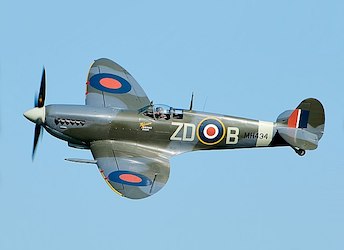
Spitfire (The Supermarine Spitfire). A British single-seat fighter aircraft used by the Royal Air Force and other Allied countries before, during, and after World War II. It was the only British fighter produced continuously throughout the war.
The Spitfire was designed as a short-range, high-performance interceptor aircraft. The original airframe was designed to be powered by a Rolls-Royce Merlin engine.
During the Battle of Britain (July–October 1940), the Spitfire captured the public’s imagination as the main RAF fighter, even though the more numerous Hurricane flew more sorties resisting the Luftwaffe, in part because the Spitfire was generally a better fighter aircraft than the Hurricane.
Spitfire units had a lower attrition rate and a higher victory-to-loss ratio than Hurricanes, most likely due to the Spitfire‘s higher performance. During the battle, Spitfires generally engaged Luftwaffe fighters—mainly Messerschmitt Bf 109E–series aircraft, which were a close match for them.
After the Battle of Britain, the Spitfire superseded the Hurricane as the principal aircraft of RAF Fighter Command, and it was used in the European, Mediterranean, Pacific, and South-East Asian theaters.
Much loved by its pilots, the Spitfire operated in several roles, including interceptor, photo-reconnaissance, fighter-bomber, and trainer, and it continued to do so until the 1950s.
The Seafire was an aircraft carrier–based adaptation of the Spitfire, used in the Fleet Air Arm from 1942 until the mid-1950s.
The Spitfire remains popular among enthusiasts. Around 70 remain airworthy, and many more are static exhibits in aviation museums throughout the world.